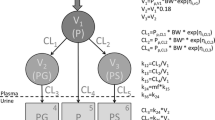Summary
Domperidone, a novel gastrokinetic and antinauseant lacking central side-effects, was administered intravenously to male Wistar rats and orally to fasted rats of either sex and to 1- and 6-day old neonates at doses of 2.5 mg14C-labelled drug/kg. The biphasic absorption of domperidone in fasted rats was extremely rapid suggesting a partial absorption from the stomach. The metabolism of domperidone was sex- and age-related: it was slower in the female rat and in the neonates. The elimination system for the metabolites was still immature in the 1-day old pups. The distribution of domperidone (and related metabolites) to the rat brain was limited, brain concentrations being lower than corresponding plasma levels in all cases. In 1-day old neonates, the blood-brain barrier was less obstructive to the passage of domperidone than in older rats.
In Beagle dogs, domperidone pharmacokinetics were described by a two-compartment model with half-lives of distribution and elimination of 6 minutes and 2.45 hours respectively. The time-courses of the drug plasma levels were similar for single and repeated (once daily for 11 months) doses of 2.5, 10 and 40 mg/kg, indicating that chronic administration of domperidone, even at high dose levels, did not alter its pharmacokinetics. AUC-values increased proportionally with the dose pointing to linear pharmacokinetics over a wide dose range.
Similar content being viewed by others
References
Reyntjens A.J., Niemegeers C.J.E., Van Nueten J.M., Laduron P., Heykants J., Schellekens K.H.L., Marsboom R., Jageneau A., Broekaert A. and Janssen P.A.J. (1978): Domperidone, a novel and safe gastrokinetic anti-nauseant for the treatment of dyspepsia and vomiting. A survey of pharmacological and clinical results. Arzneimittel-Forsch.,28, 1194–1196.
Reyntjens A. (1979): Domperidone as an antiemetic; summary of research reports. Post-grad. med. J.,55, (Suppl. 1), 50–54.
Niemegeers C.J.E., Schellekens K.H.L. and Janssen P.A.J. (1980): The antiemetic effects of domperidone, a novel potent gastrokinetic. Archs. int. Pharmacodyn.,244, 130–140.
Van Nueten J.M., Ennis C., Helsen L., Laduron P.M. and Janssen P.A.J. (1978): Inhibition of dopamine receptors in the stomach: an explanation of the gastrokinetic properties of domperidone. Life Sci.,23, 453–458.
Van Nueten J.M. and Janssen P.A.J. (1979): Effect of domperidone on gastric relaxation caused by dopamine, secretin, 5-hydroxy-tryptamine, substance P and adenosine triphosphate, 7th Int. Symposium on Gastrointestinal Motility, Iowa City.
Laduron P.M. and Leysen J.E. (1979): Domperidone, a specificin vitro dopamine antagonist, devoid ofin vivo central dopaminergic activity. Biochem. Pharmac.,28. 2161–2165.
Baudry M., Martres M.P. and Schwartz J.C. (1979):3H-Domperidone: a selective ligand for dopamine receptors. Naunyn-Schmiedebergs Arch. Pharmac.,308, 231–237.
Wiegman T., Woldring M.G. and Pratt J.J. (1975): A new cocktail for liquid scintillation counting of aqueous radioimmunoassay-samples. Clin. Chim. Acta.,59, 347–356.
Michiels M., Hendriks R. and Heykants J. (1980): A sensitive and specific radioimmunoassay for domperidone. Manuscript in preparation.
Gibaldi M. and Perrier D. (1975): Pharmacokinetics, Marcel Dekker, Inc. New York.
Michiels M., Hendriks R. and Heykants J. (1980): On the pharmacokinetics of domperidone in animals and man. II. Tissue distribution, placental and milk transfer of domperidone in the Wistar rat. Europ. J. Drug Metab. Pharmacokin., (this issue).
Bradley S.E. (1963): The hepatic circulation, Handbook of Physiology, Section 2: Circulation, ed. by W.F. Hamilton, vol. 2, pp. 1387–1439, American Physiology Society, Washington, D.C.
Dhumeaux D. and Berthelot P. (1973): Measurement of hepatic blood flow in the rat. Transhepatic catheterization of the hepatic veins. Biol. Gastroenter. (Paris),6, 49–54.
Meuldermans W., Hurkmans R., Swijsen E., Hendrickx J., Michiels M., Lauwers W. and Heykants J. (1980): On the pharmacokinetics of domperidone in animals and man. III. Comparative study on the excretion and metabolism of domperidone in rats, dogs and man. Europ. J. Drug Metab. Pharmacokin. (this issue).
Michiels M., Heykants J. and Reyntjens A. (1980): On the pharmacokinetics of domperidone in animals and man. V. Detailed study on the distribution of domperidone in rats and dogs. Europ. J. Drug. Metab. Pharmacokin. (this issue).
Van Nueten J.M. (1980): Is dopamine an inhibitory modulator of gastric motility? TIPS, 233–235.
Weihrauch T.R., Forster C.F. and Krieglstein J. (1979): Evaluation of the effect of domperidone on human oesophageal and gastroduodenal motility by intraluminal manometry, Post-grad. med. J.,55, (Suppl. 1), 7–10.
Kato R. (1974): Sex-related differences in drug metabolism. Drug Metab. Rev.,3, 1–32.
Heykants J.: unpublished results.
Lewi P.J., Heykants J.J.P., Allewijn F.T.N., Dony J.G.H. and Janssen P.A.J. (1970): Distribution and metabolism of neuroleptic drugs. Part I. Pharmacokinetics of haloperidol. Arzneimittel-Forsch.,20, 943–948.
Whitsett T.L., Dayton P.G. and McNay J.L. (1971): The effect of hepatic blood flow on the hepatic removal rate of oxyphenbutazone in the dog. J. Pharmac. exp. Ther.,177, 246–255.
Heykants J., Hendriks R., Meuldermans W., Michiels M. and Reyntjens A. (1980): On the pharmacokinetics of domperidone in animals and man. IV. Pharmacokinetics of intravenous domperidone and its bioavailability in man following intramuscular, oral and rectal administration. Europ. J. Drug. Metab. Pharmacokin., (this issue).
Author information
Authors and Affiliations
Additional information
Running title: Plasma levels of domperidone in rats and dogs.
Rights and permissions
About this article
Cite this article
Heykants, J., Knaeps, A., Meuldermans, W. et al. On the pharmacokinetics of domperidone in animals and man I. Plasma levels of domperidone in rats and dogs. Age related absorption and passage through the blood brain barrier in rats. European Journal of Drug Metabolism and Pharmacokinetics 6, 27–36 (1981). https://doi.org/10.1007/BF03189513
Received:
Issue Date:
DOI: https://doi.org/10.1007/BF03189513




